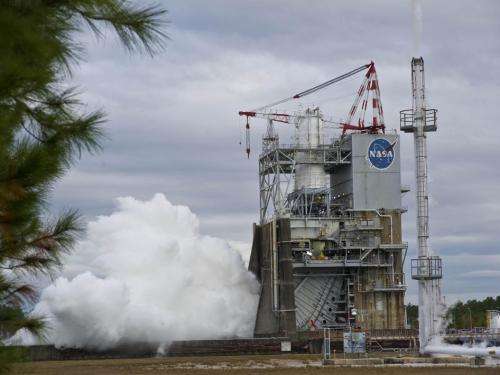NASA's first J-2X engine rockets through first round of testing; development continues strong

(PhysOrg.com) -- The best tech gift for propulsion engineers at the Marshall Space Flight Center in Huntsville, Ala.? It's NASA's first new human-rated rocket engine to be developed in 40 years. The J-2X engine -- highly efficient and versatile -- is a key component of the Space Launch System's second stage and will propel the nation's new heavy-lift launch vehicle beyond low-Earth orbit.
Using advanced technology, engineering processes and design, engineers at NASA and Pratt & Whitney Rocketdyne in Canoga Park, Calif., are setting new records in rocket engine development with the first J-2X engine unit, dubbed E10001. During 2011, E10001 rocketed through its first ten tests probing engine performance and accumulated a total hot-fire test run time of 1,040 seconds at NASA's Stennis Space Center in southern Mississippi.
"E10001 got to 100 percent power in just four tests and achieved a full flight-duration test of 500 seconds in its eighth test -- quicker than any other U.S. engine program in history," said Tom Byrd, J-2X engine lead in the SLS Liquid Engines Office. "That provides a tremendous cost savings to the Space Launch System Program. It also validates that our design is solid and allows us to move farther in engine development quicker."
In this first year of testing, the J-2X team focused on characterizing basic components' performance, understanding integrated engine system performance during prestart, start, full power operation and shutdown, as well as demonstrating full mission duration.
Today's propulsion engineers are like high-tech Santa elves churning out toys for Christmas Day: strategic and focused. New engineering processes, along with design, analysis and development advances gleaned from numerous previous programs, have provided the J-2X engine team with a solid foundation to design, build and test the engine.
For example, the first J-2X engine has demonstrated high initial quality through manufacturing and assembly. High initial quality avoids costly and time-consuming re-works and re-designs that have historically typified building large engines. "For the J-2X engine, we’ve brought together a great suite of analytical models for loads, tolerances, structural integrity and assembly sequence," said Byrd. "Truly, we had little to no surprises assembling the E10001 test engine -- the components fit together like a glove -- and proved this new way really works for designing an engine."
Modern engineering tools and processes also enable a considerably shorter, more focused test schedule, saving a great deal of cost and time. The J-2X is totally redesigned from the heritage J-2 engine that flew humans to the moon in the 1960's and 1970's. And yet, over the coming years, the J-2X engine test program will need only five percent the number of tests required to develop the original J-2 engine. That’s about 150 tests now versus about 3000 then. The engineers who successfully got humans to the moon years ago clearly knew what they were doing, but today's engineers are equipped with all sorts of modern engineering tools, processes and lessons from the past -- and the SLS Program is the beneficiary in terms of an affordable engine development test program.
Byrd noted that this year's testing wasn't all smooth sailing. For example, a seal in the J-2X main oxidizer valve cracked and had to be replaced. The crack occurred because post-test operations did not adequately purge out the propellants in the engine main injector, leading to a "pop" after some tests, which damaged the seal. No other engine parts were damaged. The "pop" was eliminated by extending the duration of a post-test injector purge, which takes longer to clear out the propellants in the test configuration on the ground than in space. This was a relatively simple fix and the J-2X test program continued on.
Looking ahead, the team is geared up to test the engine's powerpack: the gas generator, oxygen and fuel turbopumps and related ducting and valves. This testing series will push the various components to operate over a wide range of conditions to ensure part integrity, demonstrate margin and better understand how the turbopumps operate.
In addition, the team will add a nozzle extension to the E10001 engine and make associated test stand modifications to see how the engine will perform at simulated altitude conditions where the atmospheric pressure is lower than on the ground. The J-2X is the second stage engine for the SLS heavy lift vehicle, so it starts and runs at altitude during flight.
In summer 2012, a new engine -- E10002 -- will be assembled and tested followed by a third engine, E10003, in 2013. A fourth engine will be assembled and tested in 2014.
"We'll continue to learn as we test, making incremental improvements to the new fleet of engines powering humans to new destinations like the moon, Mars and beyond," Byrd added.
Like Santa's elves, Marshall's propulsion engineers are staying focused for the big day when the Space Launch System is ready for deep space. Their gift of a new U.S. advanced rocket engine will be a gift for all mankind -- powering exploration to new destinations in our solar system, discovering the unknown and improving life on Earth.
More information: For more information on the J-2X engine, visit: www.nasa.gov/mission_pages/j2x/index.html
Provided by JPL/NASA



















